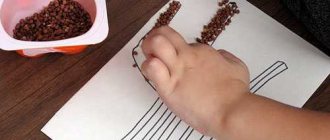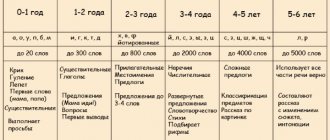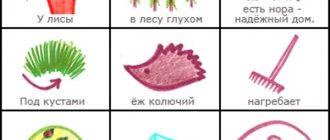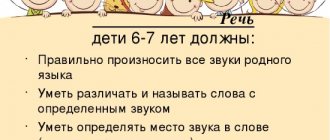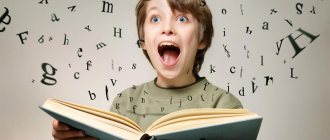Gross motor skills are a set of skills that require the use of the major muscles of the body to perform. We use these skills every day: we go to the store, run after the baby on the playground, pick up toys from the floor, make the bed. The list can be continued endlessly: we don’t attach much importance to everyday movements, we do them automatically. Although everything is a little more complicated than it seems at first glance.
Gross motor skills regulate muscle and nervous system function and are responsible for coordination and balance. This is also the basis of fine motor skills, which will help the baby make smaller movements with his hands and fingers.
Note to moms and dads:
By following the link you can watch a short video about gross and fine motor skills from Doctor of Medical Sciences and pediatric neurologist Alexey Igorevich Krapivkin.
What gross motor skills should children of different ages have?
Now we will talk about general age standards, but remember that each child is unique. If you are concerned about your baby's physical development, it is best to contact your pediatrician.
0-3 months
- holds head while lying on stomach
3-6 months
- can roll over from back to side
- rolls over completely: from tummy to back and vice versa
6-9 months
- makes his first attempts at sitting with your support
- sits by himself
- “slides” with his tummy, tries to get on all fours
- starts to crawl
1 year old
- pulls himself up to stand
- takes its first steps, holding on to you for 2 years
- walks (sometimes falls)
- runs (also not without falling)
- jumps on two legs
3 years old
- can stand on one leg
- goes up and down the steps holding your hand
- learning to climb the climbing frames on the playground
More information about the average norms for a baby’s weight, height and behavior is in the Development Calendar from FrutoNyanya. You can go to it using the link
Fun exercises for babies
This is my toy!
An activity option for a child who already knows how to grab and hold objects. When the baby is lying in the crib, put a soft rattle in his hands and gently, weakly pull it towards you. Let the baby try to pull the toy towards him. This exercise allows you to train your biceps, which are responsible for bending your arms at the elbow and turning your hands.
Expedition for children's treasures
Place your baby's favorite toys around the room or playpen and give him freedom of movement: let him try to crawl to his favorite bunnies, blocks and pyramids. This will awaken the child's interest in independent movements.
Multi-colored leaves
The exercise is suitable for babies who are already making their first attempts to stand on their feet, holding onto the sides of the crib. Glue several colored stickers on the wall next to the crib - they should be inaccessible from a sitting position. But it should be easy for the baby to get them by standing on his feet. Your little one will surely enjoy tearing leaves off the wall. Do not leave your child with stickers unattended.
Activities related to gross motor skills in children.
It is important to make the right choice of basic motor activity. Activities that are appropriate to your child's current stage of development. This will help speed up learning and set your child up for success. The child's progress in motor development then helps motivate him to achieve even more.
Basic motor activity (gross motor skills) in infants.
For infants, gross motor development is primarily focused on building muscle strength. And also to ensure that the initial children's reflexes develop into full independent control over the arms and legs.
Examples of important gross motor skills in infants:
- Tummy time (before walking)
- coups
- hand grabbing
- and, of course, crawling.
Gross motor skills in children.
For babies, the main stage, of course, is to walk and take their first hesitant steps. But in reality, the entire period is a study of balance, control and coordination. Ideal gross motor skills for toddlers include:
- dancing;
- playing with large toys that require two hands to hold;
- mixing physical activity with other activities such as storytelling and acting;
- and having fun with sensory play.
Fun exercises for older kids
Even simple exercises may have their contraindications depending on the developmental characteristics and health status of the baby. Therefore, before performing such exercises, it is necessary to consult with the pediatrician who is observing the baby. For example, diseases of the cardiovascular system may be a contraindication to active games and running. Allergic diseases require caution when using solutions for soap bubbles and playing with pillows (due to house dust); diseases of the musculoskeletal system limit riding a scooter or bicycle.
Catching up with soap bubbles
This game is suitable for kids who already walk and run confidently. On a walk or at home, blow soap bubbles and invite your baby to pop them with his palms.
It is impossible to predict the flight path of a soap bubble - that is why, trying to catch up with it, the baby will quickly change his movements, jump or, conversely, dodge.
Obstacle course
For this exercise we will need a balance bike, tricycle or scooter. Make obstacles out of plastic cones and invite your child to go around them. Another option for the exercise: draw a white line on the asphalt and ask your child to drive along it as smoothly as possible.
Aerialist
This is a home version of the chalk line exercise. Just place masking tape on the floor and let your little one walk across it with his arms outstretched. In addition, you can come up with a gaming legend. For example, that the ribbon is stretched high, high above the clouds, and the peaks of snow-white mountains are hidden under the legs.
Examples of gross motor skills.
The most prominent examples of gross motor skills in children include learning to crawl and walk. However, gross motor development covers many more skills and abilities. This includes everything from jumping, catching and throwing a ball to running and swimming. All the physical abilities that we take for granted. Because adults actually build on important earlier skills learned during childhood. Most preschoolers can perform all basic fundamental motor skills. By the time they reach school, children can usually perform complex motor activities such as riding a bicycle or playing the drum. However, true excellence even at a much later age often depends heavily on those very early skills acquired in childhood. For example, painting with a brush while standing may be difficult for people who did not crawl much as infants. Michael Jordan would not have become a basketball superstar without brilliant hand-foot coordination.
Age-related features of the development of fine motor skills of the hands
Arkhipova E.F. Doctor of Pedagogical Sciences, Professor at Moscow State Pedagogical University, Moscow.
Age-related features of the development of fine motor skills of the hands and hand-eye coordination of a child from birth have been studied and described.
After the baby , up to two to three months, the baby's hands can be clenched into a fist, but the thumb should normally be on top, and not inside the fist.
Then, after three months, the fists “open” and the child’s straightened hands begin to pat around themselves, grabbing what adults put into the child’s hands. Then the child's hand begins to reach out to what the eyes see.
After five months, the baby develops a “pincer grip,” where the thumb and index finger stand out. The child's two fingers are parallel, and then the child begins to reach out and grab small objects. Reaches for strings and pays attention to small objects.
Between three and six months , the baby actively moves his hands toward his mouth. Monitors hand movements. Under visual control, he directs his hand towards an object and grasps it.
After six months, the baby develops a “pinching grip.” The child’s fingers, thumb and index, are not connected in parallel, but in a rounded manner. And then there comes a period when the child trains in a pinch grip.
By ten months , the child should develop the “pointing gesture,” but this gesture and the separation of the index finger separately must be taught to the child. A “single” field of vision and action develops. The child's eyes guide the movement of the hand. Children transfer an object from one hand to another, they can put a spoon in a cup, cubes in a box.
There is scientific research data that predicts that if a child has gone through such a path in the development of fine motor skills of the hand until the end of the first year of life, then the brain structures all develop according to ontogenesis, that is, according to the norm.
Both hands of a child under two years of age work equally. Only towards the end of the second year of life does the leading hand begin to be determined.
In the period from one to two years, the child can draw strokes and “doodles”, can hold a cup well, lift it and drink independently. Correlates and places the square in the square slot, and lowers the oval into the oval hole. Can repeat images of several horizontal, vertical and rounded lines. Can hold two objects in one hand at once, draw with a pencil, turn the pages of a book, stack from two to six cubes on top of each other.
Between two and three years of age, a child can turn on musical toys, turn a phone dial with his finger, draw lines, reproduce simple shapes, cut with a plastic knife, and draw a cross according to a pattern. They open drawers and boxes with great interest and tip over their contents. They love to play with sand and clay. They can open screw caps, try using scissors, paint with their fingers, string beads and others.
In the period from three to four years, a child can trace along contours and copy some geometric shapes. Dexterity in the hands appears and the child can grab a ball rolling towards him. The child should hold the pencil correctly with three fingers, and not with a palm grip. He tries to copy shapes with several features and assemble buildings from nine cubes. Can draw not only with pencils, but also with colored crayons. The child can fold a square piece of paper more than once.
Between four and five years of age, a child can color simple shapes, copy capital block letters, and draw a person, depicting two to three parts of his body. Tries to copy square, star and other shapes. A complex cortical brain function “stereognosis” is formed and the child can identify objects by shape, size, texture in the bag by touch, without visual control. The child shows interest in modeling from plasticine and completes tasks according to the model. Masters self-care skills: buttons and unbuttons buttons, opens and closes zippers, unties a scarf, laces shoes, etc. All this is possible only with the correct development of fine motor skills of the fingers.
Between the ages of five and six, a child can carefully cut out pictures and write letters and numbers. Willingly adds missing details to the picture. Can deftly hit a nail with a hammer. Can easily reproduce geometric shapes based on a model.
The age of six to seven years is a sensitive period for the development of fine hand movements necessary for mastering grapho-motor skills for writing. At this age, by organizing various types of activities and systematically using training exercises, you can achieve good results in the development of hand motor skills, form grapho-motor skills and prepare the hand for writing at school.
Features of fine motor skills of children with speech disorders
Research results by N.S. Zhukova, M.M. Koltsova, E.M. Mastyukova, T.B. Filicheva confirms that training fine movements of the fingers stimulates speech development.
Children with speech impairments rarely have confident coordination of finger movements. As a rule, they experience motor clumsiness, imprecision of movements, difficulties in mastering the motor program and switching, and synkinesis (cooperative movements of other parts of the body).
Back in the middle of the last century, it was found that the level of development of children’s speech directly depends on the formation of fine movements of the fingers. If the development of movements corresponds to age, then speech development is within normal limits. If the development of finger movements lags behind, then speech development is delayed or distorted.
Research conducted by M.M. Koltsova, proved that finger movements stimulate the development of the central nervous system and accelerate the development of a child’s speech. Her research confirmed that about a third of the total area of the motor projection of the brain is occupied by the projection of the hand, which is located next to the projection of the speech motor area. And systematic work on the movements of the fingers really stimulates the maturation of the central nervous system, which manifests itself, in particular, in accelerating the development of the child’s speech.
Thus, finger gymnastics stimulates the areas of the cerebral cortex responsible for fine motor skills and speech.
This provision explains the recommendations of scientists to include in the preschool education system activities aimed at developing fine motor skills of the fingers.
Children with speech disorders acquire self-care skills late and with difficulty. Most children cannot button a button, untie a scarf, or perform other self-care tasks.
During drawing classes, they don’t hold a pencil well and their hands are tense. Many children don't like to draw. Motor clumsiness of the hands is especially noticeable during applique classes and with plasticine.
In works on appliqué, difficulties in the spatial arrangement of elements can also be traced. Violation of fine differentiated movements in the fingers is manifested when performing sample tests of finger gymnastics.
Children find it difficult or simply cannot perform an imitation movement without outside help, for example, “lock” - put their hands together, intertwining their fingers; “rings” - alternately connect the index, middle, ring and little fingers with the thumb and other finger gymnastics exercises.
During origami classes they experience enormous difficulties and cannot perform the simplest movements, since both spatial orientation and subtle differentiated movements of the fingers are required. Many children under five or six years old are not interested in playing with small construction sets, do not know how to play with small toys, and do not assemble puzzles.
Children of older preschool age have difficulties in mastering graphic skills. Some children exhibit “mirror writing of letters.” Many children do not have a finger grip on a pencil or pen. Children still have a tendency to palmally grasp a pencil.
Most children of senior preschool age experience general tension in their fingers and hands when drawing. Because of such tension, the child quickly gets tired, and the lines reflecting this tension become uneven and wavy. The more the child tries, the more the tremor-shaking of the hand will be reflected on the paper.
Many studies confirm that the level of speech development is always directly dependent on the degree of development of fine movements of the fingers.
The famous teacher V.A. Sukhomlinsky argued that “the child’s mind is at his fingertips,” therefore improving children’s fine motor skills contributes to the development of their speech and intelligence.
Aristotle called the hands “The hand is the tool of all tools.” Kant called the hands: “The hand is a kind of external brain.”
The English psychologist D. Selley also attached great importance to the “creative work of hands” for the development of children’s thinking and speech.
Currently, modern scientists have established that the level of development of children's speech is directly dependent on the degree of formation of fine movements of the fingers, and the improvement of speech directly depends on the degree of hand training.
Famous neurologist and psychiatrist V.M. Bekhterev wrote that the function of hand movement is always closely related to the function of speech, and the development of the first contributes to the development of the second.
Even the research of physiologist I.P. Pavlov. showed that speech is, first of all, muscle sensations that come from the speech organs and from finger movements to the cerebral cortex.
If you look at a medical atlas and find a “map” of the brain there, you can see that the motor speech area is located very close to the motor area of the hand. The size of the projection zone of the hand and its proximity to the motor speech zone have led many scientists to believe that training fine movements of the fingers will have a great impact on the development of a child’s active speech.
Interesting observations are noted by researchers studying the motor development of children. If a child is asked to make precise movements, he immediately begins to get tired, distracted and tends to evade the task. The inability to achieve accuracy depends on the underdevelopment of cortical mechanisms and on the lack of development of “formulas” of movement, that is, due to lack of training. The child’s apparent motor activity and tirelessness is associated with the fact that he does not make productive working movements that require precision and, consequently, a large expenditure of energy.
Fine motor skills require coordinated motor activity of the small muscles of the hand and eye. It must be mastered gradually. Fine motor skills help a child explore, compare, and classify the things around him and thereby allow him to better understand the world in which he lives. Fine motor skills help a child take care of himself independently, express himself through play and plastic arts, and provide the opportunity to gain social experience.
A number of studies pay much attention to the question of whether the development of a child’s motor skills is a consequence of the natural maturation of the corresponding structures or is it the result of learning.
The conclusions drawn indicate that both natural maturation and learning are equally significant for the formation of a child’s motor skills. This is especially true for finger motor skills.
Research shows that imitation plays an important role in mastering hand movements. There are three types of imitative reactions: repetition of one’s own movements; repetition of familiar adult movements; repetition of new movements.
According to L. S. Vygotsky, drawing “is a kind of graphic speech, a graphic story about something.” Special studies have shown that there is a kind of critical moment when simple pencil scribbling and meaningless scribbles begin to mean something.
The main stages of development of gross motor skills in children.
Understanding how your child's gross motor skills develop is important. This is important in order to select suitable learning activities. These exercises stimulate the child but do not challenge him beyond his current abilities.
The development and acquisition of new gross motor skills follow certain predictable patterns. It is also divided by age of the child, marked by stages of gross motor development.
From birth to three years of age, there are over one hundred unique stages of gross motor development alone.
